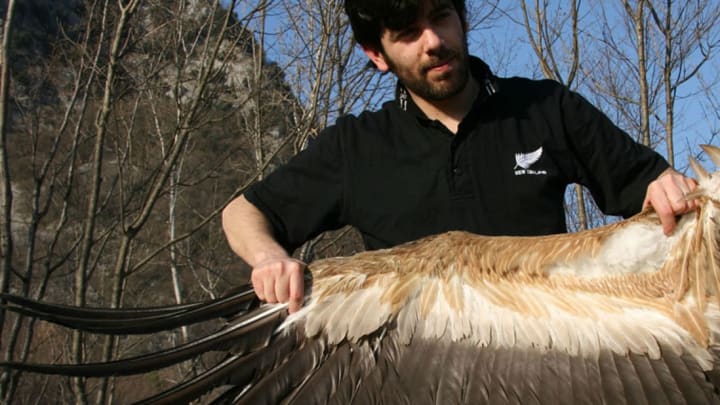Once thought of as thick-browed brutes, Neanderthals have been getting more credit for their intellect lately. Recent evidence suggests that our extinct cousins, Homo neanderthalensis, buried their dead, used tools, and perhaps could speak. Neanderthals may have also accessorized with raptor feathers and talons—and, according to new research, they went through great pains to do so.
To get inside the Neanderthal mind, Matteo Romandini, an anthropologist at the University of Ferrara in Italy, has been butchering birds for himself. Romandini and his team have found that it takes considerable effort to fashion an eagle claw for a necklace or collect feathers from a griffon wing, as Neanderthals may have in the past. They recently published the results of their experimental archaeology in Quaternary International.
Neanderthals, the closest extinct relatives of humans (their DNA can be found in many of us today), lived in Europe and western Asia from about 400,000 years ago until they mysteriously vanished about 40,000 years ago. At some prehistoric campsites, like the Krapina rock shelter in Croatia and Fumane Cave in northern Italy, researchers have found the remains of raptors alongside Neanderthals’ fossil record of skeletons and stone tools. Deliberate cut marks on these bird bones and claws suggest that Neanderthals exploited birds—not just to get bird meat for food, but to collect bird feathers and claws for personal adornment.
For his latest round of experiments, Romandini contacted raptor rehab centers in Europe to find carcasses of raptors that had died due to natural or accidental causes. He was able to use three different species in the study: the lammergeier, or bearded vulture (Gypaetus barbatus), the Eurasian griffon (Gyps fulvus), and the Eurasian eagle-owl (Bubo bubo).
Romandini and his team used flint flakes and tools to dismember the carcasses and disconnect the raptors’ flight feathers. In every case, they wrote, detaching the carpometacarpus (the tip of the wing bone where the feathers are attached) was a tricky operation, requiring manual twisting and cutting with their stone tools. You can see steps of the process below.
The researchers found that the scraping marks they left on the wing bones in their experiments were indeed comparable to the little notches left on the prehistoric bones found at Fumane Cave and from other Neanderthal sites. However, two of the prehistoric wing bone fragments found at Fumane Cave had far more cut marks than would be expected just to remove the feathers.
Below, a fragment of an ulna from a vulture found in the cave.
The researchers speculate that these small bones were being fashioned into tools, perhaps similar to the awl made out of bird bone found at a Homo sapiens site in South Africa.
In a previous study in PLOS One, Romandini and his colleagues conducted similar experiments to remove the claws of the same raptor species. The researchers found that the act of separating tendons from the talons left tiny incisions on the base of the bony claws exactly comparable to the marks on the prehistoric claws discovered at other Neanderthal camps like Rio Secco in Italy and Mandrin Cave in France.
“I was surprised by the difficulty to obtain the claws of these large raptors,” Romandini tells mental_floss. “The flint makes it very hard to break the keratin, which is very thick around the claws. The expenditure of time and energy certainly implies special attention to derive these particular objects.”
And that’s exactly why a taste for jewelry is interesting to anthropologists: It implies Neanderthals had impressive cognitive abilities. Accessorizing one’s body suggests a capacity for abstract thinking and symbolic thought—not to mention planning and effort.
All images courtesy of Matteo Romandini via University of Ferrara
